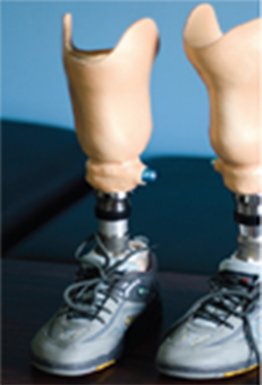An amputation is the removal of any protruding part of the body but usually refers to an arm or leg. The limb may be removed for a number of reasons including an injury, chronic infection,trauma or vascular disease. The person may also be born with one or more limbs missing. The position of the amputation is important; people with an amputation above the knee or elbow may have more limited use of the limb, than those with an amputation below the joint.
A person with an amputation may:
- experience feelings of depression,hostility, denial and helplessness;
- have a problem with accepting their own body image;
- require the use an artificial limb; or
- have a persistent awareness of the amputated limb, or a burning or throbbing sensation at the site of the amputation.
A person with an amputation may have an artificial limb and it is important that the stump of the limb is cared for through massage and the application of moisturizing cream.
Heat and humidity can cause irritations to the amputated area through perspiration and rubbing against the socket of the artificial limb. The amputation can alter body shape and density. This can have implications for maintenance of body balance. People with recent amputations may need to re-learn past skills.
Programming Considerations
- Use of equipment during an activity may need to be adapted to accommodate the person.
- Be aware of each individual’s capabilities.
- Ask what support is required – do not assume without asking.
- Think about what other tasks individuals could also assist with in an activity, if they cannot actively participate.
- Be aware of what type of modified or supportive equipment is available.
Strategies for Inclusion
- Get other participants to provide assistance if appropriate.
- Modify activities where necessary and possible, so that all of the group can participate
- Make goals achievable.
Behavior Management Issues
- Provide constant encouragement and lots of positive feedback.

